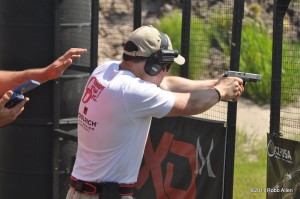One of the big differences between a GM level shooter and an A-class shooter is that the GM does everything the A-class guy does, but the GM does it on the move, faster. But like any other skill in practical shooting, we can sometimes tend to get focused on “doing things while we’re moving” to the point where we’re actually not helping our scores in major matches. I’ve fallen into the trap myself once or twice, where I’ve shot an array on the move because I could not because it was necessarily the best way to shoot the stage.
There are some activities you want to always try and do while you’re moving, such as reloading. Standing reloads are a great way to kill a stage, so whenever possible try to do those on the move in USPSA. If you’re shooting IDPA, any opportunity you can find to reload on the move (behind cover, of course) should be taken. But shooting on the move isn’t always the case. This is why knowing your own ability and being able to make sound decisions based on that ability is going to be important for match success.
In a match, shooting on the move isn’t a “can I” question, but a “should I” question. Frequently, the answer is yes, you should. The real question isn’t “what’s the absolute fastest I can shoot this stage and still shoot good points?” Because that may mean taking an array on the move, or it may mean…not. Catch 22: you don’t know how fast you shoot on the move. Solution: 3rd person video. Get a buddy to tape you next time you’re at a match. Because I can tell you one thing for sure; when you’re shooting on the move it may feel like you’re going 100 MPH with your hair on fire, but when you go back and look at the tape, you might be surprised at how slow you’re going.
Your shooting goals are also going to influence how you shoot a stage. So, for example say you’re a B-class production shooter. Do you push yourself to shoot the stage the way the GMs shoot it an accept the mistakes as part of the learning process? Or do you shoot the best B-class run you have in you? That answer depends on whether or not you want to be a B-class shooter for the rest of your career.
Ultimate, the decision to shoot on the move or not is going to be made in the stage planning process, which is why learning to break down a stage is a critical skill. I’ve had literally an email asking me what’s the best way to learn how to break a stage down, and the best answer I have is “shoot more matches, watch guys who are better than you.” When I first started shooting USPSA, I didn’t do a lot of walking through stages. I just sort of shot the stage. Then I started walking stages, planning reloads, stuff like that and my ability to break down a stage improved. Then I started talking to more experienced shooters on how to break down a stage. Then I started talking to buddies about how to break down stages. It’s a constant process of improvement, because as you get better about stage breakdown, you learn to see places where you can shave a bit of time here and there. I’m sure that in 2 years I’ll see things that I’m not aware of right now.
Remember this: when you shoot USPSA, you’re not competing against other shooters, your testing your ability against a course someone else designed. Unless you know your own skills, you’ll never be able to push yourself to the max.

No comments:
Post a Comment